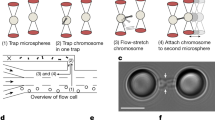Abstract
The exceptional cytology provided by polytene chromosomes has made Drosophila melanogaster a premier model for chromosome studies, but full exploitation of polytene cytology is impeded by the difficulty in preparing high-quality chromosome spreads. Here we describe use of high pressure to produce formaldehyde-fixed chromosome spreads, which upon light-microscopy examination reveal structural detail previously observed only in electron microscopy preparations. We demonstrate applications to immunofluorescence and in situ hybridization.
This is a preview of subscription content, access via your institution
Access options
Subscribe to this journal
Receive 12 print issues and online access
$259.00 per year
only $21.58 per issue
Buy this article
- Purchase on Springer Link
- Instant access to full article PDF
Prices may be subject to local taxes which are calculated during checkout



Similar content being viewed by others
References
Hochstrasser, M. & Sedat, J.W. J. Cell Biol. 104, 1455–1470 (1987).
McKenzie, S.L., Henikoff, S. & Meselson, M. Proc. Natl. Acad. Sci. USA 72, 1117–1121 (1975).
Udvardy, A., Maine, E. & Schedl, P. J. Mol. Biol. 185, 341–358 (1985).
Eissenberg, J.C. & Elgin, S.C.R. Trends Genet. 7, 335–340 (1991).
Hart, C.M., Zhao, K. & Laemmli, U.K. Mol. Cell. Biol. 17, 999–1009 (1997).
Lindsley, D.L. & Zimm, G.G. The Genome of Drosophila melanogaster (Academic Press Inc., New York, 1992).
Kuhn, E.J., Hart, C.M. & Geyer, P.K. Mol. Cell. Biol. 24, 1470–1480 (2004).
Sullivan, W., Ashburner, M. & Hawley, R.S. (eds.) Drosophila Protocols (CSHL Press, Cold Spring Harbor, NY, 2000).
Stephens, G.E., Craig, C.A., Li, Y., Wallrath, L.L. & Elgin, S.C. Methods Enzymol. 376, 372–393 (2004).
Bonner, J.J. Dev. Biol. 86, 409–418 (1981).
Yao, J., Munson, K.M., Webb, W.W. & Lis, J.T. Nature 442, 1050–1053 (2006).
Li, Y., Danzer, J.R., Alvarez, P., Belmont, A.S. & Wallrath, L.L. Development 130, 1817–1824 (2003).
Zhou, X.S., Rui, Y. & Huang, T.S. Exploration of Visual Data (Kluwer Academic Publishers, Boston, 2003).
Forsyth, D.A. & Ponce, J. Computer Vision—A Modern Approach (Prentice Hall, Upper Saddle River, 2002).
Raginsky, M. & Lazebnik, S. in Advances in Neural Information Processing Systems (Weiss, Y., Schölkopf, B. & Platt, J., eds.) 1105–1112 (MIT Press, Cambridge, 2006).
Acknowledgements
Development of the method was supported by the US National Institutes of Health grant 2RO1GM058460 to A.S.B.
Author information
Authors and Affiliations
Contributions
D.V.N. improved the polytene chromosome spreading technique, developed the high-pressure treatment approach and performed the light microscopy; I.K. optimized and performed the electron microscopy sample preparation and immunostaining; A.S.B. coordinated the project and provided general guidance for the work.
Corresponding author
Ethics declarations
Competing interests
The authors declare no competing financial interests.
Supplementary information
Supplementary Fig. 1
Mechanical equipment and materials. (PDF 203 kb)
Supplementary Fig. 2
Average quality spreads of D. melanogaster salivary gland polytene chromosomes, prepared using the high pressure method. (PDF 163 kb)
Supplementary Fig. 3
Comparison of chromosomal spreads at the same location prepared by different techniques: 87A-C heat-shock puffs in polytene chromosomes of D. melanogaster salivary glands. (PDF 124 kb)
Supplementary Fig. 4
Boundary element scs' maps to junction between decondensed region within 87A heat shock puff and minor bands A8-10. (PDF 854 kb)
Supplementary Fig. 5
Comparison of light microscopy (described protocol) with EM. (PDF 1004 kb)
Supplementary Fig. 6
Comparison of the resolution in experiments with immunostaining obtained using conventional procedures with images acquired as described here. (PDF 902 kb)
Supplementary Video 1
Spreading and pressing procedures. (WMV 2615 kb)
Rights and permissions
About this article
Cite this article
Novikov, D., Kireev, I. & Belmont, A. High-pressure treatment of polytene chromosomes improves structural resolution. Nat Methods 4, 483–485 (2007). https://doi.org/10.1038/nmeth1049
Received:
Accepted:
Published:
Issue Date:
DOI: https://doi.org/10.1038/nmeth1049
This article is cited by
-
Karyotype features of trematode Himasthla elongata
Molecular Cytogenetics (2016)
-
Proximity ligation assays of protein and RNA interactions in the male-specific lethal complex on Drosophila melanogaster polytene chromosomes
Chromosoma (2015)



